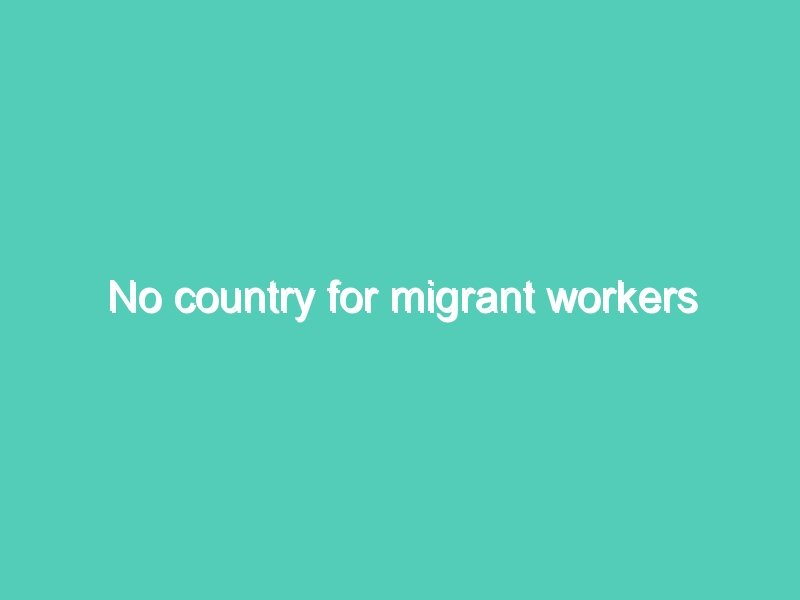Mohammad Osman Goni, a migrant worker, shuttered his tiny green grocery shop in Malaysia and flew home to Bangladesh, a day before the Southeast Asian nation locked itself down on March 18 amid the corona virusrampage.
Malaysia started the nationwide “movement control order,” as it is officially known, hours after it reported its first fatality from the disease. It was a moment of reckoning for Mr. Goni. He feared that he would end up paying a hefty fine for keeping his shop open.
“I realised it’s time to go home,” Mr. Goni, 41, said in an interview from his home in the central district of Munshiganj. “My earnings collapsed. I suffered a big loss.” Mr. Goni’s case offers insight into migrant workers’ struggle in times of crisis as global remittances are projected to decline sharply by about 20% this year due to the economic crisis induced by COVID-19. It also shows the depth of economic chills consuming the entire migrant community and the countries that largely depend on remittances to keep up economic growth momentum.
Mr. Goni is one of about 19,000 migrant workers who returned to Bangladesh from Malaysia between February 18 and March 18. About 2,00,000 Bangladeshi workers returned home in the same period, mostly from West Asian nations, before the country shut its airspace. The projected fall in remittances, which would be the sharpest in recent history, is largely due to a decline in the wages and employment of migrant workers, the World Bank said in a report on April 22.
Remittances to low- and middle-income countries may fall by 19.7% to $445 billion, representing a loss of a crucial financing lifeline for many vulnerable households.
Remittances to Bangladesh and other South Asian nations are forecast to decline by 22% to $109 billion in 2020, following the growth of 6.1% in 2019.
The slowdown is likely to directly affect remittance outflows from the U.S., the U.K., and EU countries to South Asia. Falling oil prices will affect remittance outflows from West Asian countries and Malaysia, which together supplied $10.88 billion to Bangladesh last fiscal year. Signs of a deceleration are already on the horizon in the country. Inward remittances in March dropped 13% year-on-year to $1.29 billion, lowest in 15 months, according to data from the central bank.
“As countries respond to the COVID-19 crisis, there is a strong case for supporting the migrant workforce, which is vital to many economies. There are several interventions governments should consider,” Dilip Ratha, a World Bank economist, wrote in a report. Mr. Ratha recommended supporting stranded migrants and their access to health, housing, and other social services, and offering incentives to reduce the cost of remittance services.
In the medium to long-term, policies should encourage the interoperability of online remittance systems and support efforts to reduce remittance costs, which remain far too high for some of the poorest regions, according to Mr. Ratha.
Digital transfers
The coronavirus crisis may have one upside — more people may start sending money home digitally, which the World Bank says can be 50% cheaper than traditional transfers, where recipients have to go to a shop to pick up the money.
In Bangladesh, bKash saw a surge in remittance transfers through its channel. Expatriates sent around 150% more remittances on a daily average in April, compared to the first three months of this year through online and wallet-based money transfer companies from around the world, bKash, Bangladesh’s largest mobile money company, said in a statement.
Much about the pandemic is maddeningly unclear. Economies have nosedived, societies have paused. And the impacts of the disease on migrant workers in parts of the world are swift and severe. For Mr. Goni, the job loss is not the central torment, but uncertainty over a future job is. He pleaded with his friend, a university teacher in Dhaka, for help, but a job is hard to come by anytime soon.
Just after Mr. Goni arrived home on March 17, he had another battle to fight: his wife was pregnant and the delivery date loomed. He worried that the nationwide lockdown in Bangladesh that shut public transport would delay his wife’s access to a hospital. “It’s an uncertain time.”
MY OPINION
When times of helplessness arise, it is critical that workers make the best use of the most remote available resources in order to make sure their families don’t die of hunger. This is where digital transfers come into the picture. The upside of using digital transfers as a medium to send remittances are many, the first being the more people avoid the usage of currency during these times of pandemic, the lower re the chances of infection. The more are the chances of an economy turning into a cashless one eventually, and the poor and underprivileged to see the silver lining in the clouds.
Article Witten by- Lavanya Ambalkar
Law Student- (Symbiosis Law School, Pune)
(HRDI Work from Home Internship)



